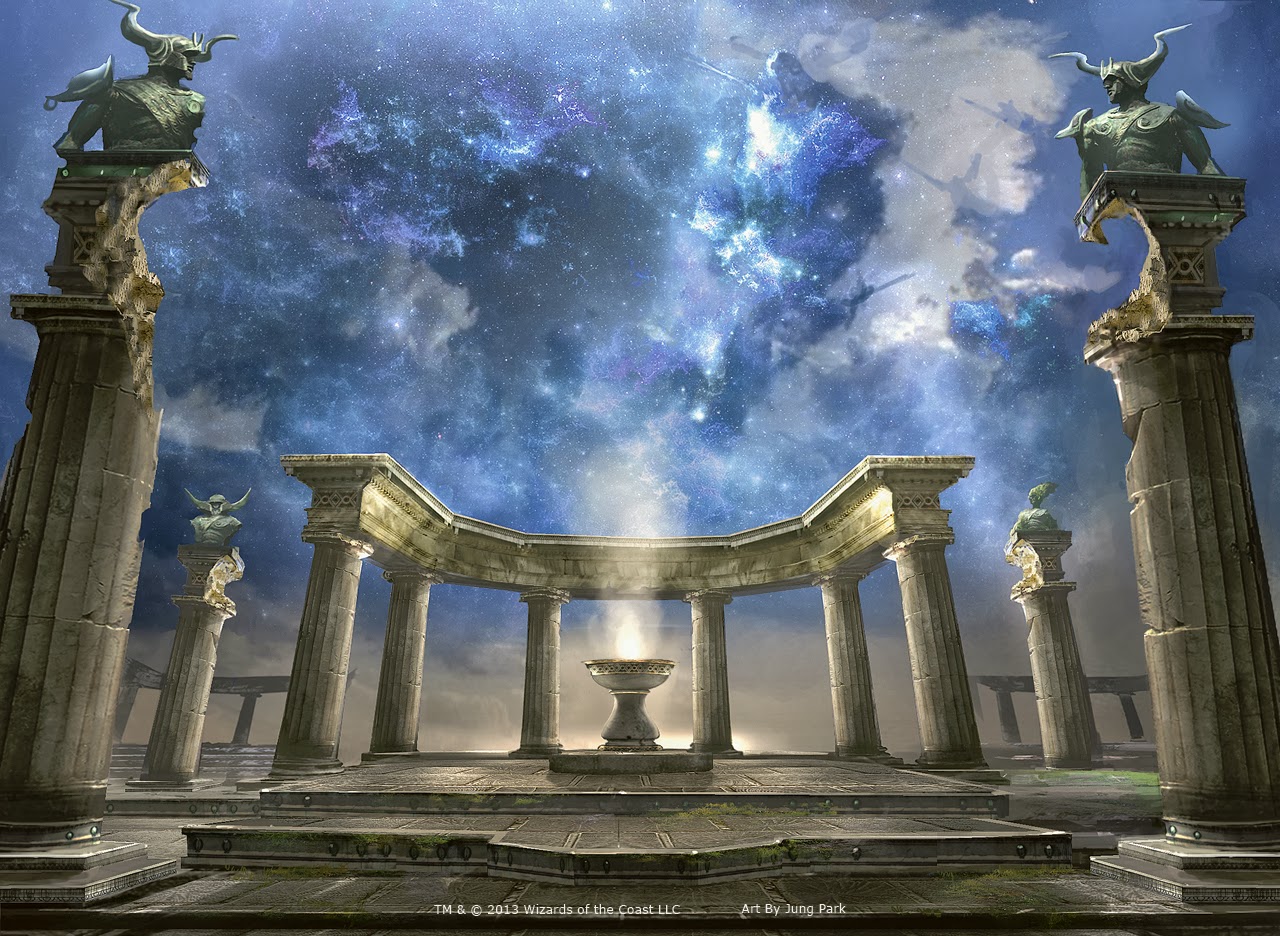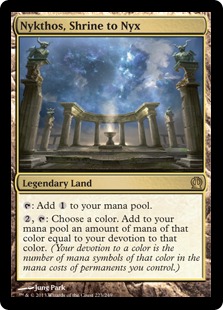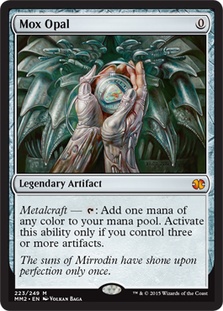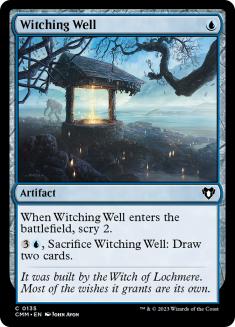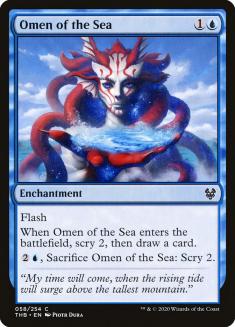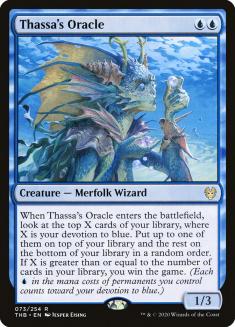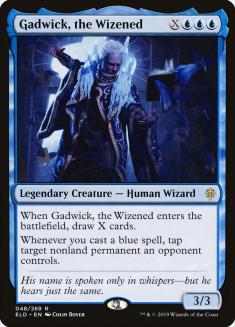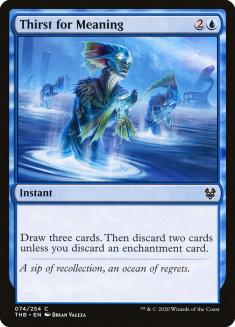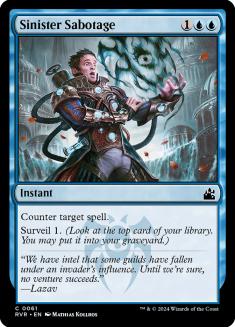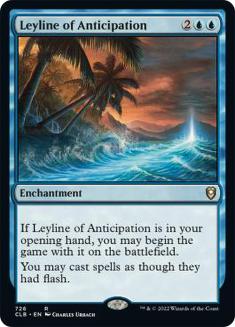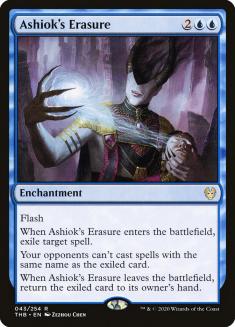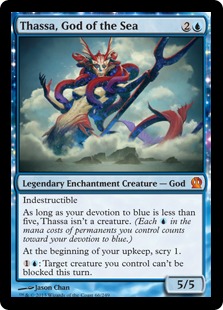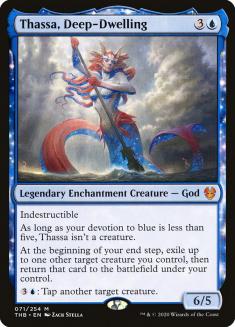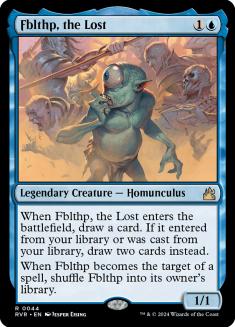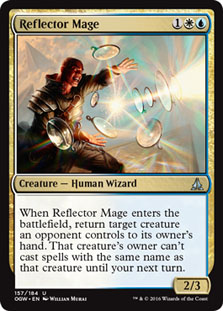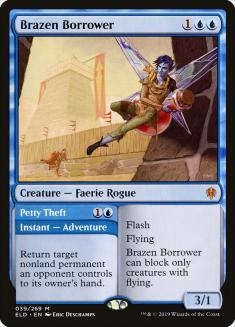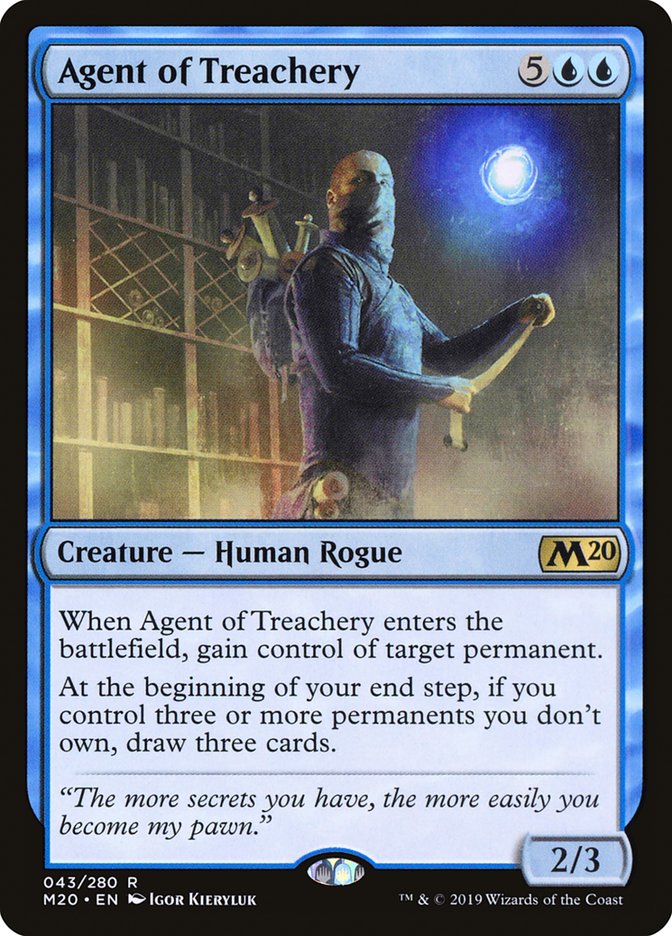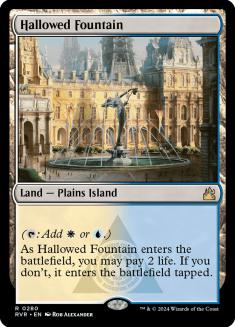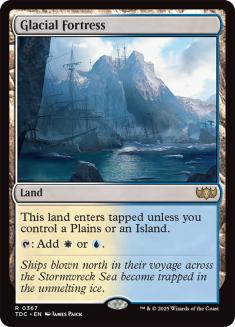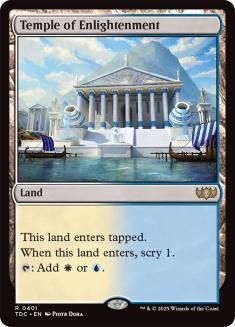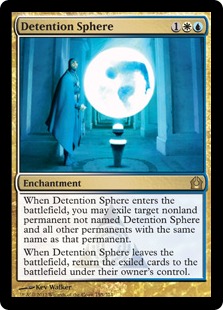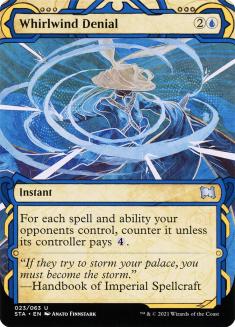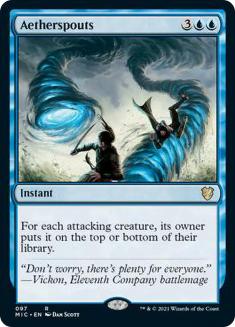Many readers may remember my first advice for the Pioneer Players Tour when the format was announced, which was to find a card you think should be banned, and prove that Wizards of the Coast (WotC) made a mistake by allowing you to play with it. I’ve also argued from the beginning that Nykthos, Shrine to Nyx is one such card. Lands that tap for multiple mana are among the most dangerous categories of Magic cards to print, and Nykthos comes with extremely little opportunity cost and offers incredible mana generation if you’re willing to build your deck around it.
WotC has been much less inclined to go after unfair mana sources in their bannings than I would be, and I played with Mox Opal in Modern for years as a result. Now, I’m working to demonstrate that they’re making the same mistake in Pioneer. Perhaps surprisingly, I think blue is the best color to take advantage of Nykthos, and I have a deck that I think is essentially without close historical analog that does so.
Let’s get straight to my current list:
Creatures (20)
- 2 Thassa, God of the Sea
- 3 Reflector Mage
- 1 Fblthp, the Lost
- 2 Agent of Treachery
- 4 Gadwick, the Wizened
- 2 Brazen Borrower
- 2 Thassa, Deep-Dwelling
- 4 Thassa's Oracle
Lands (24)
Spells (16)

This is a “combo deck” in that you’re looking to draw a precise combination of cards, but it plays as much like a ramp deck as anything else. The reason I believe this is the best Nykthos deck is that, now that Oath of Nissa and Once Upon a Time are banned, blue has the best tools to quickly find Nykthos.
Between Witching Well, Omen of the Sea, and Thassa’s Oracle, this deck has an incredible ability to control its draw steps, and the mana that it spends doing so is mana invested into permanents that add devotion for Nykthos.
While we’re essentially down a card for Witching Well and arguably down a card for Leyline of Anticipaton, none of that matters at all if we can find our deck’s central combo:
The basic play pattern with this deck is to spend the first turns building up our devotion with spells that offer card selection to make sure we have all the essential pieces; cast interactive spells that contribute to our devotion, like Reflector Mage and Ashiok’s Erasure; and then draw two to six cards with Gadwick, at which point the game is essentially over. We’ll typically spend the next turn or two playing out all the cards we’ve drawn, at which point we’ll have around ten devotion, and then we’ll use the Nykthos on the battlefield and an extra in our hand to get two Nykthos taps in a turn, which will let us Gadwick for fifteen-plus while leaving two mana up. Then we can win by casting Thassa’s Oracle. Other games, we can simply turn on either Thassa and win by attacking.
So that’s what we’re building to. Now let’s go over how we get there. First, the cards I’m not playing:
My first take on this deck included spells to help me play a more controlling, reactive game, but the more I play, the more I learn just how much better my deck functions when all my plays contribute to my devotion, and the deck plays out much better without these. I have enough tools to find Gadwick, the Wizened that I just don’t need the weaker card draw. These happened to be the cards I was playing before, but the bigger point is that I want every card in my maindeck to be a permanent.
With that out of the way, let’s get to the cards I am playing:
The Core
4 Leyline of Anticipation: This is the best card to see in your opening hand by a wide margin. It makes it much easier to turn on Thassa, God of the Sea and Thassa, Deep-Dwelling and lets you ambush attackers with them. It makes your Nykthos far more explosive and allows you to play at instant speed to maximize Ashiok’s Erasure. After the opening hand, we typically scry them away, but I wouldn’t consider playing fewer than four.
4 Witching Well: When I was taking a little longer to set up because I had instants in my deck, I sometimes questioned whether this was worth a card, especially since I often found myself scrying it away, but now that my deck is a little more focused, I think Witching Well is absolutely essential. If I have Nykthos in my hand, it’s essentially a Search for Tomorrow in that it gives me one more mana once I start using Nykthos, but it’s much better to draw late and it helps make sure that I have Nykthos and something to do with it. This kind of incredibly low-cost, very sticky devotion is exactly what this deck is about.
4 Omen of the Sea: This is another core setup card, and everything about Witching Well applies here, except that it costs one more mana and I draw a card immediately, which makes it even better.
4 Thassa’s Oracle: This card is incredible. It would be good in this deck even without the alternate win clause because the UU casting cost is great, the body is sized to stay on the battlefield and maybe do some blocking, and the card selection is outstanding. Early on, this reliably smooths my draws, in the mid-game it’s essentially a Vampiric Tutor with a body that potentially generates mana, and in the late-game it literally wins the game.
4 Gadwick, the Wizened: A perfect mana sink and enabler, if I draw too many I can just cast one on Turn 3 or 4 to build up devotion, which essentially draws me three extra cards on my next Gadwick. This is the last absolutely essential card.
Four copies of each of these cards are completely locked in, and the deck would have to fundamentally change to another deck before I’d consider trimming a single copy of any of these from the maindeck.
I’ve liked 24 lands in this strategy, so that means I get sixteen remaining cards, all of which should be blue permanents to round out the deck. At this point, this is getting reminiscent of building Urza decks, where I started with a core of four copies each of Mox Opal; Mishra’s Bauble; Gilded Goose; Arcum’s Astrolabe; Oko, Thief of Crowns; and Urza, Lord High Artificer — that’s six cards, but it was a roughly twenty-land deck, so Nykthos, Shrine to Nyx would be the analog of Mox Opal here, leaving both decks with sixteen flexible slots).
The Flex Slots
4 Ashiok’s Erasure: This is the last card I’m playing four copies of. It’s a great way to get an interactive spell into my deck without missing out on adding devotion, and it plays very well with both bounce effects and Leyline of Anticipation. I sideboard it out against aggressive decks, but it’s important to have to be able to beat cards like Ugin, the Spirit Dragon.
2 Thassa, God of the Sea: This often feels like I put a random Steel Leaf Champion in my ramp/combo deck, but it’s so durable and such a nightmare for opposing creature decks, and good enough at closing, that it likely earns its spot, though I’d be more likely to play one than three copies.
2 Thassa, Deep-Dwelling: I only recently started playing this card and it’s completely blown me away. Curving Reflector Mage into Thassa, Deep-Dwelling basically ends the game against most creature decks, blinking Thassa’s Oracle lets you basically draw whatever you want every turn, and your opponent is required to concede if you ever get this with Agent of Treachery from what I’ve seen. I’d sooner play three than one, but I’m good enough at finding my copies that I’m a little too worried about drawing two, so I’m hesitant about that switch.
1 Fblthp, the Lost: I added this because it seemed like a freeroll and supports Thassa, Deep-Dwelling, and it’s been very good. Without Thassa, Deep-Dwelling, it’s essentially a bad Omen of the Sea, but I’d be thrilled to play more of those. A second copy of Fblthp is tempting.
3 Reflector Mage: I imagine it isn’t surprising that cutting Thirst for Meaning for Reflector Mage had a transformative impact on my aggro matchups. Against decks without creatures, this card is clearly horrible, but it’s been everything I’d hoped against creature decks, and I could easily see playing the fourth.
2 Brazen Borrower: Overall, this is a little worse than Reflector Mage against creature decks, but I like having a two-mana interactive spell, and it’s been very important for using Gadwick tap triggers defensively when I don’t have a Leyline. The flexibility is great, but the raw power is likely the lowest among my flex slots, so two copies have felt about right.
2 Agent of Treachery: Previous versions of this deck had some trouble with resolved planeswalkers, and this is a very powerful card to draw to, especially when I can cast it on Turn 4 or 5 in a deck with Thassa, Deep-Dwelling. Before I was playing Thassa, I had Mass Manipulation and Walking Ballista in these slots, but I think I like Agent most. I want some kind of big effect like this I think, but I could see playing only one copy.
Lands
4 Nykthos, Shrine to Nyx: This is the entire point of the deck.
4 Hallowed Fountain: With enemy-colored decks in Pioneer, it’s possible to have an interesting discussion about whether shocklands are the correct multicolor lands for the deck. For allied-color decks, it isn’t. I’m splashing Reflector Mage, so I’m playing Hallowed Fountain.
4 Glacial Fortress: See above.
2 Temple of Enlightenment: Ten white sources has felt about right given how much card selection I have to find them. I’d feel uncomfortable with fewer and I don’t want more tapped lands. While this deck already has a lot of card selection, it’s really built around taking advantage of that, so I prefer this to the other tapped options.
Sideboard
1 Reflector Mage: I need to have four of these in my 75, as they’re extremely important against aggressive decks.
4 Detention Sphere: Previously, I had Engulf the Shores in my sideboard, when my lands were all Islands. With Glacial Fortress and Temple of Enlightenment, I think it’s a little too unreliable, and this is another way to add interaction that contributes to my devotion. It’s my most recent addition, but seems pretty clearly correct.
3 Rest in Peace: There are a lot of graveyard decks and this card has no impact whatsoever on any card in my deck.
2 Aether Gust: I’m a little uncertain about this card, since maximizing my permanent count has felt so good, but it’s nice to get cheaper interaction against aggressive decks. I could see a case for Cerulean Drake over this.
2 Mystical Dispute: This is a fantastic card for ramp decks, since it makes it much easier to push your important spells through.
2 Whirlwind Denial: World Breaker and Ulamog, the Ceaseless Hunger are important cards to respect.
1 Aetherspouts: A little spice against aggro decks, potentially cuttable.
Sideboarding
Don’t touch the core cards. I almost added “when in doubt” to the beginning of that sentence, since I used to sideboard out Witching Well sometimes, but I think that was just wrong and you shouldn’t do it.
For the most part, you’ll be cutting Ashiok’s Erasure and Agent of Treachery for Reflector Mage, Detention Sphere, and Aetherspouts against aggro decks. The fact that this is a clean swap is part of why I’m uncertain about Aether Gust in the sideboard, since finding room for this involves cutting into the core, trimming Thassa, or upgrading Fblthp or Brazen Borrower, which is somewhat low-impact.
Against ramp and control, you’ll generally start by cutting Reflector Mage for counterspells, which is some argument for a third flexible counterspell like a Summary Dismissal or Disdainful Stroke over an Aether Gust in the sideboard.
Against combo, you’ll typically cut Reflector Mage, Agent of Treachery, and maybe Brazen Borrower and bring in whichever cards make sense against their combo, like Rest in Peace and the counterspells.
Things should be pretty straightforward once you know to leave the core intact. If you’re sideboarding out all the white cards, consider also cutting one or two copies of Temple of Enlightenment, especially if you’re on the draw.
Nykthos Blue is an absolute blast to play, since you get enough mana to do crazy things very quickly, and the card selection offers a high level of agency and planning. I’m still in the process of learning whether this deck has what it takes to win the Players Tour, but in the meantime, I’ve loved exploring and playing with it, and I can honestly say I wouldn’t have written this article if secrecy before a Players Tour were still a priority of mine.

